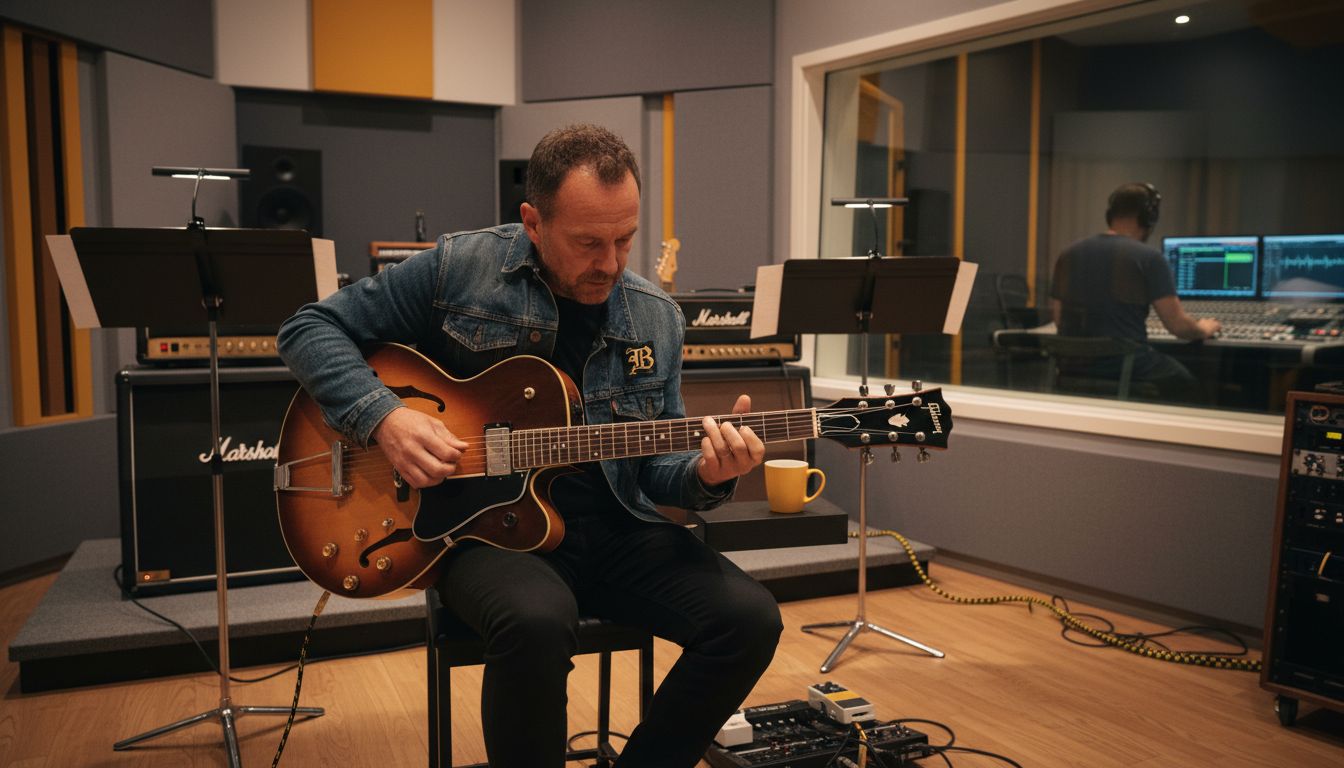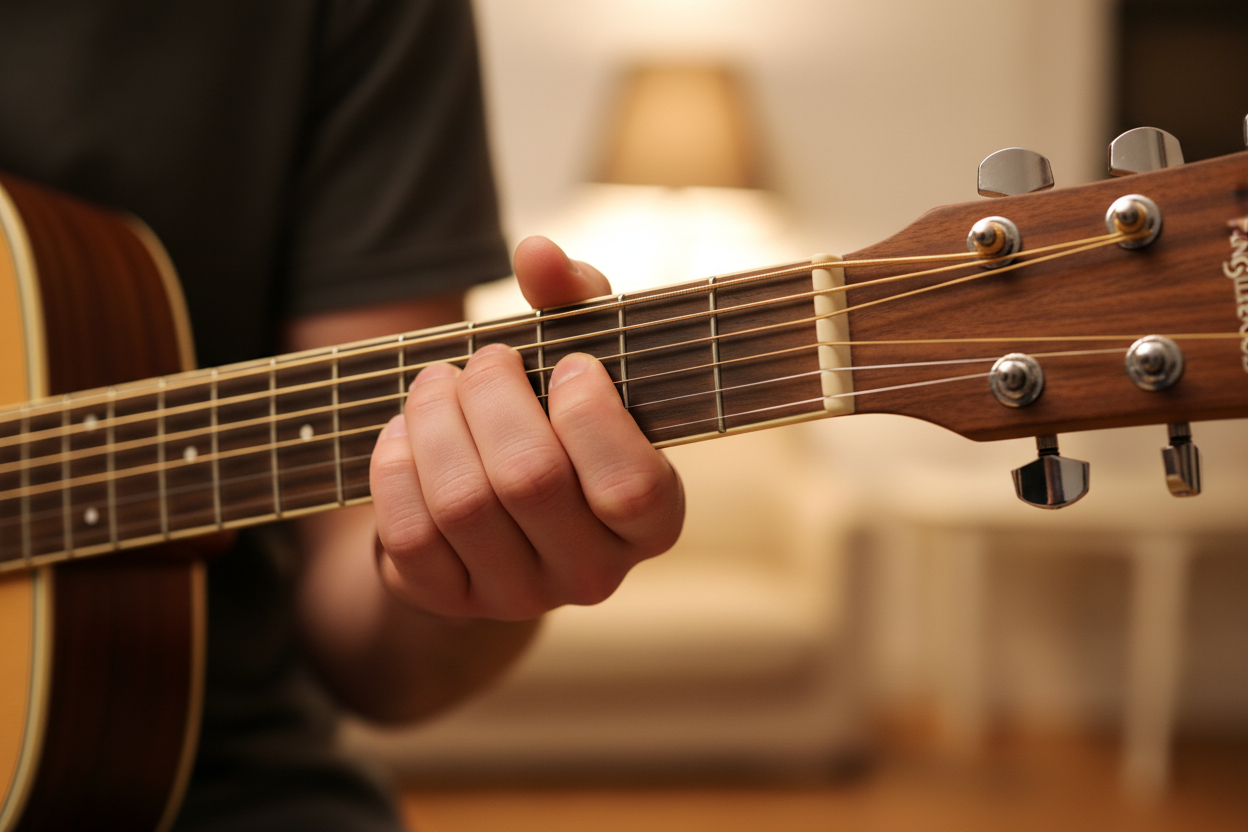-
1. The major pentatonic…
-
So, why can we use both?
-
Dominant 7th Arpeggios
-
Minor7b5 (half diminished) Arpeggios
-
The Guitar Club
The minor pentatonic is an absolute beaut of a scale! We'd be lying to ourselves if we said that we don't all live it, and use it A LOT! However, as you grow as a guitar player and start to experience a palette of new sounds, you learn that there's a time and a place to use the minor pentatonic, and a time and a place to avoid it.
In this blog post I want to talk to you about how we might start to develop beyond the minor pentatonic in our blues improvisation and playing. So, before I crack on with this epic lesson, let me quickly introduce myself. My name is Dan, and I am the founder and CEO of Your Guitar Academy and the Guitar Club. I have been teaching guitar for over 20 years now, and as a company we have taught over 500,000 students over the last 10 years, some online and some in person. Blues is my first love, and I'm very excited to bring you a few cool ideas in this post that you can take with you and easily adapt to your playing.
We're going to break this down into 3 core ideas; the major pentatonic, dominant 7th arpeggios and m7b5 arpeggios. There is even more you can do, but getting a good grip on these three will hugely help your blues playing, and can generally be quite easily applied. So, let's start with the major pentatonic.
The minor pentatonic has the following construction: 1, b3, 4, 5 & b7. So we basically pick 5 notes ("penta" means 5, "tonic" means note) from the minor scale. The key elements that make this sound minor are the b3rd and the b7th. The root, 4th and 5th degrees are all notes that we can see in both major and minor scales.
The major pentatonic, however, has the following construction: 1, 2, 3, 5 & 6. So we're picking 5 different notes from the major scale here to form the major pentatonic. The key elements here that make it sound major are the 3 and the 6… The rest are the same in both major and minor. So, take a look at this diagram:

Well, for me the answer lies in the way we construct dominant 7th chords and the concept of the "blues key". When we talk about blues keys, rather than saying we are playing in "A minor" for example, or "A major", as we would do for most genres of music, we say "we're playing in A blues"! This is because unlike any other genre of music, the key is constructed using purely dominant 7th chords.

A dominant 7th chord is constructed based on a major chord plus the addition of a b7th (borrowed from the minor scales, as you can see above). So you get this formula: 1, 3, 5 & b7th. So, on a purely concept level, the major 3rd of the dominant chord gives you that access to the major sound, and the b7th gives you the access to the minor sound. Super simple, and for me that's enough, alongside the experience of trying these ideas to be happy that it works. However, we can dive a little deeper still…
If we take the A7, D7 and E7 in a 12 bar blues, and lay out all the notes available to us in order starting from A, we get the following selection: A, B, C, C#, D, E, F#, G & G#. If we now write out our A minor pentatonic we get the notes A, C, D, E & G. All of these notes are available to us across the 12 bar blues. Equally, if we take the major pentatonic notes in A we get: A, B, C#, E & F#. All of these notes are also available to us across the 12 bar blues. So it all fits, it all works and you can rely on it to work for you! To get you started I would take the A minor pentatonic box 1 and A major pentatonic box 2, and learn to interchange them, creating a bit of a super scale. It looks something like this:



Next up, we can advance your playing by starting to consider playing the arpeggio of the "change". What I mean by this is to take the 3 chords of the blues, the I, IV, V chords, and start to play over them with their respective arpeggio. So, in the key of A Blues, you would have an A7, D7 and E7 chord, and therefore an A7, D7 and E7 arpeggio. Let's start by learning two shapes that can help here:



Once you have practiced these simple shapes, it's time to try them within a 12 bar structure. I would recommend starting simple and taking one specific position in the 12 bar to practice this idea. For example, let's take the first time you get to the D7 chord as a good starting point. Look at the chord chart below, and when you hit the D7 play the whole, or fragments of, your D7 arpeggio!

Voila! That's a great start to this concept, and something you can apply to any point of the 12 bar. I wouldn't simply just do arpeggios, as it can get a little dull, but sprinkling them in around the major and minor pentatonic can make a huge difference! If you want some more practical examples, check out our Blues Essentials Level 2 course!
Finally, let's take a big leap up and try to use something called a m7b5 arpeggio in our blues playing. This is a big step into playing "through the changes", which essentially means that you choose to play an m7b5 arpeggio as you move into the next chord, to help create an awesome transition. But, how do we do that, and why use m7b5?
The m7b5 chord is a half diminished chord, and as you may well know, the diminished chords create a lot of tension that needs to be resolved. When using dominant 7th chords, you can very easily substitute a 7th chord for a m7b5, but you have to do it in a certain way. This certain way is by taking the major 3rd of the dominant 7th and starting the m7b5 from there. So, for example, if you're playing an A7 chord, you can take the major 3rd of that chord (the C#) and play a C#m7b5 arpeggio. This works because the C#m7b5 arpeggio is essentially an A9 chord (A7 plus the 9th) without the A root note! Pretty cool eh? Check this out:



And there you have it, another way to advance your 12 bar blues improvisation. If you need further help with this then please do check out our Blues Essentials Level 3 course right here.
I really hope this blog post helped you on your musical journey! If you are interested in furthering that journey and really taking a massive leap in the right direction with your playing, why not check out our Guitar Club. You can get completely free access for 7 days, no credit card or commitment required, and we'll give you a a pathway of learning and access to all of our courses, community and so much more! Very much looking forward to hearing from you on our community!




Share:
Choosing the Perfect Guitar for Your Worship Band
Best Accessories for Your Yamaha Revstar Guitar: Enhance Your Playing Experience